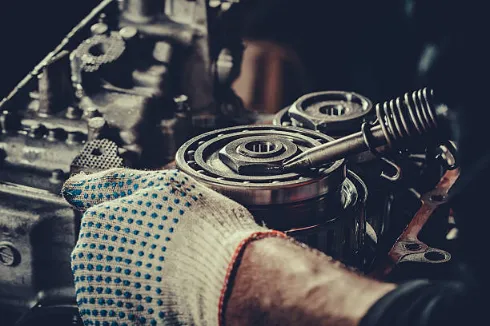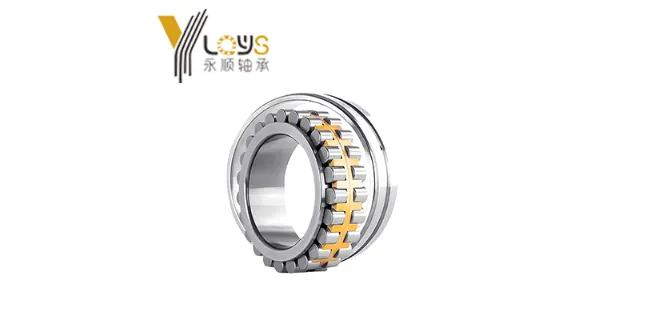हाई स्पीड ट्रांसमिशन बीयरिंग्स: चिकनी गियर शिफ्ट और दीर्घायु सुनिश्चित करना
2025-10-24

आज’ तेजी से गति वाली ऑटोमोटिव दुनिया, ट्रांसमिशन पहले कभी नहीं की तरह सीमाओं को धकेलते हैं। हाई स्पीड ट्रांसमिशन बीयरिंग सब कुछ चिकनी से चल रहे हैं। वे तीव्र भार और गति को संभालते हैं, जिससे गियर शिफ्ट आसान महसूस होते हैं।
आधुनिक ट्रांसमिशन में बीयरिंग की भूमिका
ट्रांसमिशन बीयरिंग वास्तव में क्या करते हैं
ट्रांसमिशन बेयरिंग घूर्णन शाफ्ट का समर्थन करते हैं जो हर दिन टोक़ और गति से निपटते हैं। वे गियरबॉक्स के अंदर घर्षण और गर्मी को कम करते हैं। उनके बिना, भाग एक-दूसरे के खिलाफ पीसेंगे, जिससे तेजी से टूटना होगा। ये असर एक पुल की तरह कार्य करते हैं, भारी भार ले जाने के दौरान घटकों को स्वतंत्र रूप से चलाने देते हैं।
ले थ्रस्ट बेयरिंग्सउदाहरण के लिए। अक्षीय असर के रूप में भी जाना जाता है, वे मुख्य रूप से शाफ्ट के समानांतर बलों को संभालते हैं। रेडियल बेयरिंग के विपरीत जो साइड लोड लेते हैं, थ्रस्ट बेयरिंग अक्षीय या थ्रस्ट लोड पर ध्यान केंद्रित करते हैं। वे घूर्णन मशीनरी में स्थिर संचालन सुनिश्चित करते हैं। अक्सर ऑटोमोटिव ट्रांसमिशन, क्लच, प्रशंसक, पंप और कंप्रेसर में पाए जाते हैं। थ्रस्ट बेयरिंग एक आवास में गेंदों या रोलर्स का उपयोग करते हैं, जिसमें सब कुछ जगह पर रखने के लिए एक पिंजरा होता है।
उच्च गति अनुप्रयोगों परिशुद्धता की मांग क्यों करते हैं
आधुनिक ट्रांसमिशन तंग सहिष्णुता के साथ उच्च आरपीएम पर घूमते हैं। इसका मतलब है कि बीयरिंग्स को जगह पर होना चाहिए। कोई भी घूर्णन असंतुलन गियर शिफ्ट को गड़बड़ कर सकता है, जिससे झटके या देरी ह सटीकता है ’ टी बस अच्छा, यह’ प्रदर्शन के लिए आवश्यक है। रेसिंग कारों या इलेक्ट्रिक वाहनों के बारे में सोचें; एक छोटी दोष बड़ी समस्याओं का कारण बन सकती है। और हाँ, कभी-कभी इंजीनियर अनदेखा करते हैं कि कैसे उच्च गति से गर्मी चीजों को विकृत करती है, लेकिन उसे जल्दी पकड़ने से सिरदर्
ट्रांसमिशन में उपयोग किए जाने वाले सामान्य असर प्रकार
बॉल बेयरिंग, रोलर बेयरिंग और सुई बेयरिंग ट्रांसमिशन में बहुत कुछ दिखाते हैं। प्रत्येक की भार और डिजाइन आवश्यकताओं के आधार पर अपनी ताकत है।
बॉल बेयरिंग कई सेटअप्स के लिए जाने के लिए हैं। उनके पास चाप के आकार के नालियों के साथ आंतरिक और बाहरी अंगूठियों के बीच गेंदें हैं। ये रेडियल लोड, दोनों दिशाओं में अक्षीय लोड, या एक मिश्रण को संभालते हैं। उच्च गति घूर्णन के लिए महान। कुछ ग्रीस से पूर्व भरे हुए आते हैं या सील होते हैं, जो आवास डिजाइन को सरल बनाते हैं। घर्षण कम है क्योंकि स्लाइड के बजाय गेंदें रोल होती हैं। लेकिन समय के साथ, गेंद भारी दबाव के तहत समतल हो सकती हैं, इसलिए नियमित रूप से रेटिंग की जांच करें।
रोलर बेयरिंग भारी कर्तव्यों के लिए कदम उठाएं। बेलनाकार रोलर बेयरिंगउदाहरण के लिए, रोलिंग तत्वों के रूप में सिलेंडर का उपयोग करें। वे बाहरी अंगूठियों पर रैखिक संपर्क के साथ विशाल रेडियल लोड का समर्थन करते हैं, एक व्यापक क्षेत्र पर बल फैलते हैं। पवन टर्बाइन या खनन उपकरण जैसी भारी मशीनरी के लिए एकदम सही। एन और एनयू जैसे प्रकार अक्षीय विस्थापन की अनुमति देते हैं, जबकि एनजे और एनयूपी थ्रस्ट लोड को भी संभालते हैं। वे थकान और झटके का विरोध बॉल बेयरिंग की तुलना में बेहतर करते हैं। माउंटिंग सीधा है, और वे चरम परिस्थितियों में काम करते हैं।
सुई असर सुई जैसे पतले, लंबे रोलर्स के साथ रोलर असर के एक प्रकार हैं। वे छोटे स्थानों में उच्च भार क्षमता पैक करते हैं। गेंद या मानक रोलर कॉम्पैक्ट डिजाइनों के लिए आदर्श, जैसे कि कंप्रेसर या इंजन कनेक्टिंग रॉड में। वे अलग-अलग गति या खराब स्नेहन के साथ दोलन गति और कठोर वातावरण के अनुरूप हैं। सामान्य तौर पर रोलिंग बेयरिंग, इन सहित, कम प्रारंभिक घर्षण, आसान स्वैप के लिए मानक आकार हैं, और रेडियल और अक्षीय दोनों भार ले सकते वे दक्षता में सादे असरों को हराते हैं, विशेष रूप से उच्च या कम तापमान पर।

ट्रांसमिशन बीयरिंग के सामने चुनौतियां
चरम संचालन शर्तें
ट्रांसमिशन में बीयरिंग क्रूर परिस्थितियों का सामना करते हैं। उच्च गति, बदलता टोक़, और तापमान स्विंग स्थिर हैं। इसके अलावा, स्नेहक समय के साथ टूट जाते हैं या दूषित हो जाते हैं। यह’ खराब मौसम में मैराथन चलाने की तरह, सब कुछ तेजी से पहनता है। धोका असर, अक्षीय भार के लिए निर्मित, अभी भी संघर्ष करते हैं यदि गर्मी बहुत अधिक बनती है।
माइक्रो वाइब्रेशन और शोर की समस्या
गियर जाल बीयरिंग में प्रतिध्वनि बनाता है। छोटी अपूर्णताएं सूक्ष्म स्तर पर कंपन को बढ़ाती हैं। इससे शोर होता है जिसे ड्राइवर नफरत करते हैं। उच्च गति सेटअप में, यह’ और बुरा; कंपन पूरी प्रणाली को हिला सकता है। कभी-कभी, यह’ एस न केवल असर, तेल में गंदगी बज़ में जोड़ती है। चीजों को साफ रखना एक टन की मदद करता है।
समय के साथ पहनने और थकान
पिटिंग और स्पैलिंग सामान्य पहनने की समस्याएं हैं। वे सतहों पर चिप दूर करते हैं, प्रदर्शन को नुकसान पहुंचाते हैं। खराब स्नेहन इसे तेज करता है, जल्दी विफलता का कारण बनता है। रोलर बेयरिंग उनके डिजाइन के कारण बेहतर पकड़ सकते हैं, लेकिन यहां तक कि वे लगातार तनाव के तहत थकान भी करते हैं। नियमित रूप से जांच इन्हें स्पॉट करती है इससे पहले कि वे ट्रांसमिशन को तोड़ दें।
उच्च गति प्रदर्शन के लिए इंजीनियरिंग नवाचार
उन्नत सामग्री और गर्मी उपचार
उच्च शुद्धता स्टील बीयरिंग में थकान प्रतिरोध को बढ़ाता है। गर्मी के उपचार उन्हें कठिन बनाते हैं। सिरेमिक हाइब्रिड्स उच्च गति पर स्थिरता जोड़ते हैं। इन सामग्रियों को पहनने पर काट दिया जाता है। के लिए बेलनाकार रोलरइसका मतलब है कि पसीना तोड़ने के बिना सदमे के भार को संभालना।
स्नेहन अनुकूलन
विशेष तेल और ग्रीस एक बड़ी भूमिका निभाते हैं। वे एक फिल्म बनाते हैं जो घर्षण गर्मी को रोकती है। ट्रांसमिशन में, सही मोटाई भागों को ठंडा रखती है। सुई बेयरिंग्स, अपने छोटे आकार के साथ, इसे तंग स्पॉट्स में लाभान्वित करते हैं। लेकिन अगर तेल गंदा हो जाता है, तो यह’ खेल खत्म हो गया, दूषित सब कुछ बर्बाद कर देता है।
सटीक विनिर्माण और माइक्रो सहिष्णुता नियंत्रण
सीएनसी पीस सुनिश्चित करता है कि रेसवे सुपर चिकनी हैं। सतह परिष्करण और तंग सहिष्णुता सब कुछ नियंत्रित करती है। शाफ्ट संरेखण और प्रीलोड सटीकता भी मामला है। गेंद असर यहां कम घर्षण के साथ चमकते हैं, लेकिन रोलर्स को भारी भार के लिए उस सटीकता की आवश्यकता होती है। यह’ संतुलन के बारे में सब कुछ।
चिकनी गियर शिफ्ट सुनिश्चित करना: असर की छिपी भूमिका
गियर और शाफ्ट के बीच घर्षण को कम करना
चिकनी असर बदलावों को महान महसूस करते हैं। वे लगातार अक्षीय समर्थन प्रदान करते हैं। घर्षण गिर जाता है, इसलिए गियर और शाफ्ट आसानी से चलते हैं। थ्रस्ट बेयरिंग यहां मदद करते हैं, स्थिरता के लिए अक्षीय भार को नियंत्रित करते हैं। कम घर्षण के बिना, शिफ्ट क्लंक हो जाते हैं।
गियर स्लिपेज और कठोर शिफ्टिंग को रोकना
असर कठोरता और निकासी टोक़ हस्तांतरण को प्रभावित करती है। सटीकता सही समय पर बदलाव रखती है। बेलनाकार रोलर, उनके रेडियल लोड समर्थन के साथ, उच्च टोक़ क्षणों में फिसलाई को रोकते हैं। यह’ स्वचालित या मैनुअल में समान रूप से महत्वपूर्ण है।
शोर, कंपन और कठोरता (एनवीएच) नियंत्रण
इंजीनियर वास्तविक दुनिया के सिमुलेशन के साथ एनवीएच का परीक्षण करते हैं। कम घर्षण बीयरिंग ड्राइवर असुविधा को काट देते हैं। कंपन दमपन जैसी तकनीकें मदद करती हैं। सुई असर दोलन भागों में जड़ता को कम करें, चीजों को शांत करें। एक चिकनी सवारी शांत असरों से शुरू होती है।
स्मार्ट डिजाइन और रखरखाव के माध्यम से असर जीवनकाल का विस्तार करना
सही स्थापना और संरेखण
गलत संरेखण तेजी से पहनने और गर्मी का कारण बनता है। सभा के लिए सर्वोत्तम प्रथाओं का पालन करें। सही फिट समस्याओं से बचने के लिए। रोलर बेयरिंग आसानी से माउंट होते हैं, लेकिन इसे गलत मिलता है और जीवनकाल गिर जाता है।
नियमित स्नेहन और तेल स्वच्छता
स्वच्छ स्नेहक संदूषण को रोकते हैं। फ़िल्टर और परिवर्तन चक्र महत्वपूर्ण हैं। गेंद असर, उनके साथ सील विकल्पलेकिन वैसे भी जांच करें। अच्छा तेल जीवन को बड़े समय तक बढ़ाता है।
प्रारंभिक विफलता का पता लगाना
शोर के लिए सुनें, कंपन महसूस करें, गर्मी की जांच करें। कंपन विश्लेषक जैसे उपकरण समस्याओं को जल्दी से पहचानते हैं। थ्रस्ट बीयरिंग में स्पैलिंग पकड़ना पूरे सेटअप को बचाता है।
उच्च गति ट्रांसमिशन बीयरिंग में विशेषज्ञ
उच्च आरपीएम वातावरण के लिए सटीक इंजीनियरिंग
योंगशुन सटीकता और सतह की गुणवत्ता पर ध्यान केंद्रित करता है। उनके बीयरिंग उच्च आरपीएम को बिना झटकाव के संभालते हैं। विनिर्माण में नियंत्रण शीर्ष प्रदर्शन सुनिश्चित करता है।
कठोर धीरज और एनवीएच परीक्षण
परीक्षण वास्तविक भार, गति और गर्मी की नकल करते हैं। यह बाजार से पहले समस्याओं को पकड़ता है। एनवीएच जांच चीजों को शांत और चिकनी रखती है।
OEM और बाद की आवश्यकताओं के लिए अनुकूलित असर समाधान
योंगशुन ऑटोमोबाइल, ईवी और भारी गियर के लिए अनुकूलित विकल्प प्रदान करता है। चाहे ओईएम या आफ्टरमार्केट, वे विशिष्ट ट्रांसमिशन आवश्यकताओं को फिट करते हैं।
निष्कर्ष
हाई स्पीड ट्रांसमिशन बीयरिंग शिफ्ट को चिकनी और सिस्टम को विश्वसनीय बनाते हैं। सटीकता, स्मार्ट स्नेहन और सामग्री की प्रगति इसे चलाती है। योंगशुन एक विश्वसनीय निर्माता के रूप में बाहर खड़ा है, जो टिकाऊ समाधान प्रदान करता है जो अंतिम होता है।
सामान्य प्रश्न
प्रश्न 1: ट्रांसमिशन में असर के मुख्य प्रकार क्या हैं?
आम में उच्च गति, कम घर्षण आवश्यकताओं के लिए बॉल बेयरिंग शामिल हैं; भारी रेडियल लोड के लिए बेलनाकार जैसे रोलर बेयरिंग; और कॉम्पैक्ट, उच्च भार स्थानों के लिए सुई असर।
प्रश्न 2: रेडियल लोगों से थ्रस्ट बेयरिंग कैसे अलग हैं?
थ्रस्ट बीयरिंग शाफ्ट के समानांतर अक्षीय भार को संभालते हैं, जबकि रेडियल बीयरिंग लंबवत बल लेते हैं। धक्का प्रकार एकल या डबल दिशा में आते हैं।
प्रश्न 3: उच्च गति संचरण में असर क्यों विफल होते हैं?
अक्सर खराब स्नेहन, दूषण, विसंरचना, या थकान से। गर्मी और टोक़ जैसी चरम परिस्थितियां पहनने की गति बढ़ाती हैं।
प्रश्न 4: क्या सुई असर गेंद असर को बदल सकते हैं?
कभी-कभी, हाँ, तंग जगहों में उच्च भार की आवश्यकता होती है। लेकिन बॉल बेयरिंग उच्च परिशुद्धता और कम टोक़ के लिए बेहतर है।
प्रश्न 5: ट्रांसमिशन बीयरिंग की जांच कितनी बार की जानी चाहिए?
उपयोग पर निर्भर करता है, लेकिन नियमित तेल परिवर्तन और कंपन जांच मदद करती हैं। शुरुआती संकेतों के रूप में शोर या गर्मी की तलाश करें।







